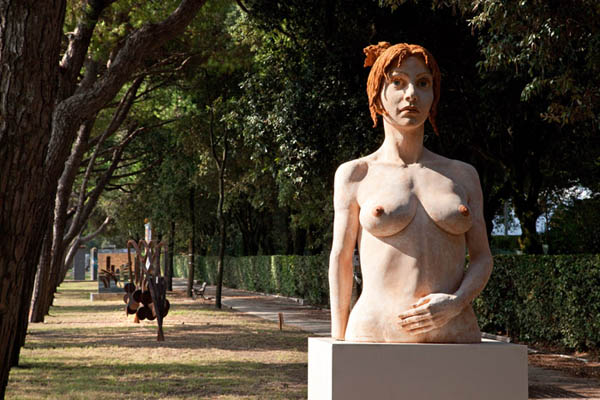ITALY – MARCO CORNINI
A young girl with swollen breasts, her left hand on the stomach, her eyes turned towards tomorrow. Marco Cornini’s monumental sculpture arrives at Lido. It is one of his contemporary feminae, even with mascara on her eyelashes and rouge à lèvres. I challenged him some months ago while looking round his studio cluttered with finished pieces – bronzes, but mainly terracottas, which are by now consigned to history, having been presented at so many exhibitions. To take part in OPEN 12 he needed a large-sized work of art, something which could sum up his poetics concentrated on the eternal feminine. This huge bust of a woman, with perfect proportions and built according to the rules of great classical sculpture, borrows the idea of beauty and the sacred theme of motherhood from the past. The first dea Mater in history dates back to the Neolithic Age, if you consider the many Venuses found all over Europe. During the centuries, with the migrations of people and the development of different cultures, the Mater’s roles miniaturized into various female deities. So Gaia took on distinct personifications, for example, to oversee sensual love (Ishtar-Astarte-Aphrodite Pandemos-Venus), fertility of women (Triple Hecate, like the three stages of life), fertility of the land (Persephone/Proserpine), hunting (Artemis/Diana). But where does this protective figure come from? In the Theogony Hesiod explains how broad-breasted Gaia, the protectress of the gods of Olympus, reigned after Chaos. She brought forth Uranus (the starry sky), Pontus (the fruitless depths of the sea) and the mountains by herself, without sweet union of love. Then she lay with Uranus and bore Oceanus, Coeus, Crius and the Titans. After them Cronus (time), the wiliest and most terrible of her children, was born. He hated his powerful father and overthrew him. But Cronus, who became meanwhile the most powerful god, began to fear he could be overthrown by his own sons and so he devoured them as soon as his wife Rhea bore them. The desperate woman turned to Gaia to try to save her last child, Zeus. With him the first pantheistic religion, organized in a rigorous hierarchy, took shape. Gaia, the Mother of all living beings, would survive only in epic poems and legends, but her almighty secret, the ability to give birth, has come down to us intact. From the Snake Goddess created in Crete at the beginning of the second millennium B.C., to the Sardinian figurines which were found near Cagliari, in Sardinia, and may date back to the recent Neolithic Age; from the clay works of art of ancient Greek, to Byzantine mosaics; from the Venus statues of the classical age, up to the Madonnas of all Christian painting, the Mother Goddess has kept her protective strength which is able to control the excesses of the human race. And Cornini places a contemporary one at Lido, in front of the sea, with those distant eyes which, as stated in the title, can look beyond.
Text by Anna Caterina Bellati
